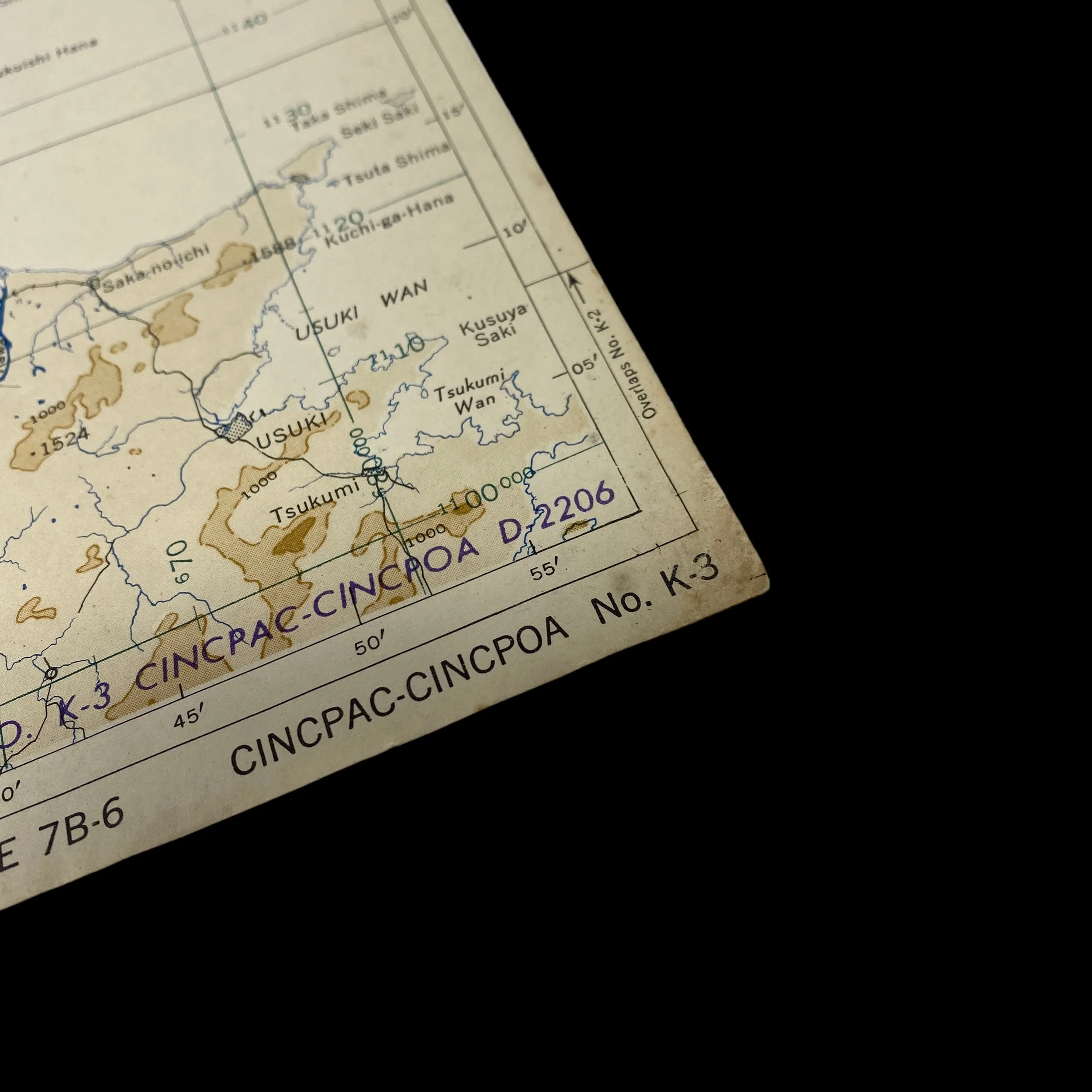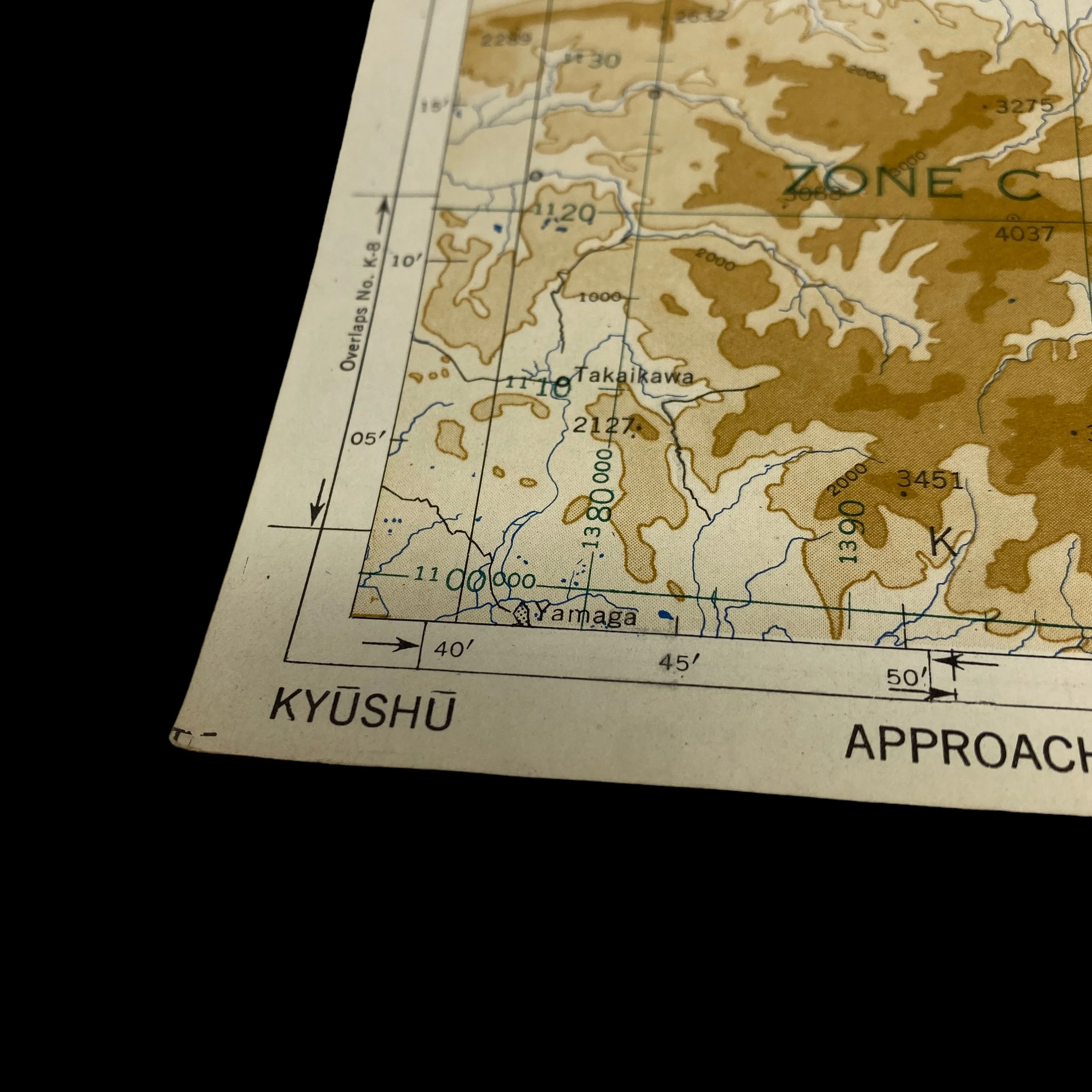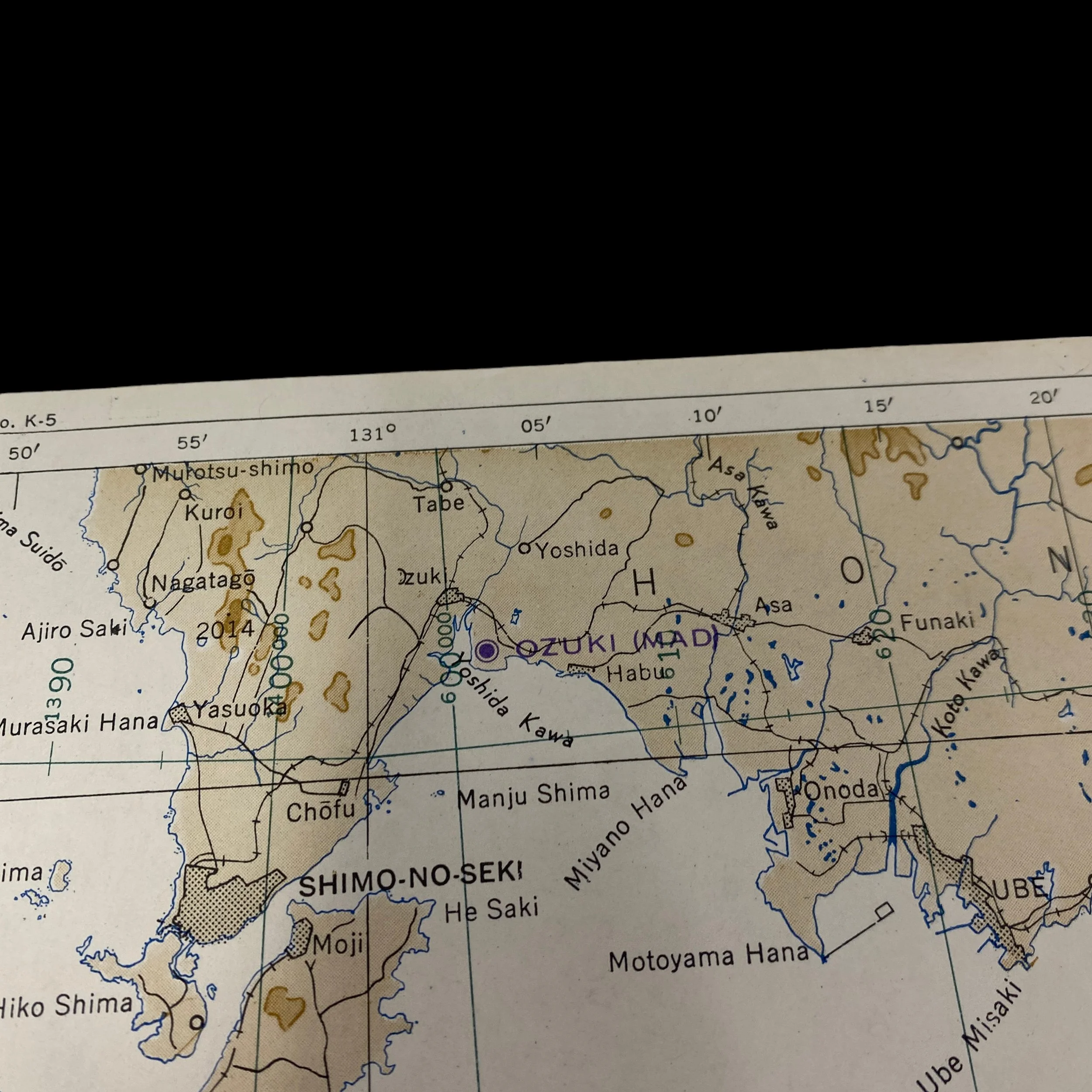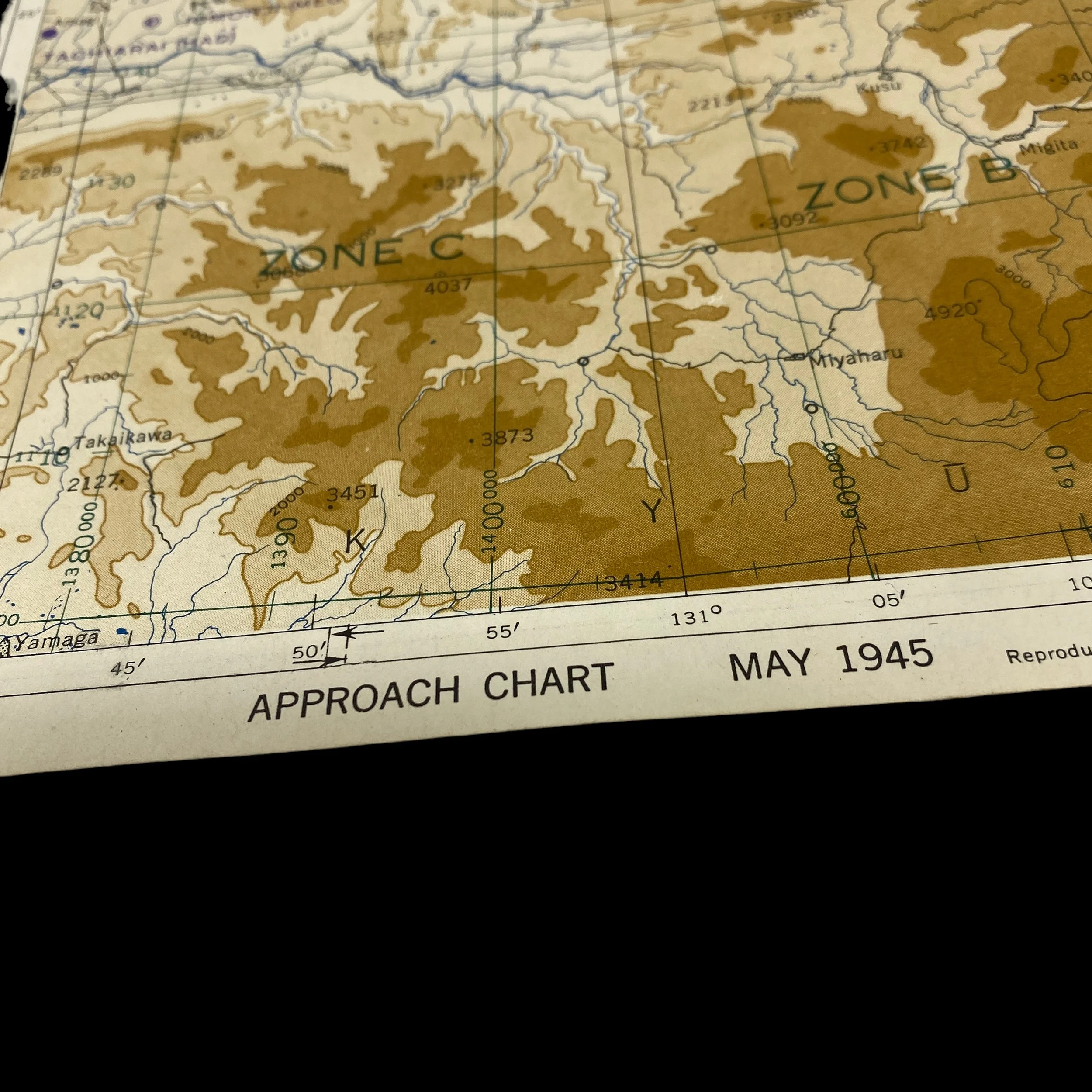VERY RARE! 1945 WWII USS Enterprise (CV-6) Air Group TARGET MAP "KYUSHU" Mainland Japan Missions *





















VERY RARE! 1945 WWII USS Enterprise (CV-6) Air Group TARGET MAP "KYUSHU" Mainland Japan Missions *
Comes with a hand-signed C.O.A. and a full historical write-up
This rare, original, and museum-grade ‘RESTRICTED’ WWII “APPROACH TARGET MAP” was used by Lt. Moore who served as an American pilot on the USS Enterprise (CV-6) Air Group. In the actual USS Enterprise ‘After Action’ reports it states, “It is recommended that "Top Secret" material - Operation Plans and Orders - be reclassified downward to "Secret or Confidential" prior to the start of an operation by a sufficient length of time to permit of adequate and timely distribution to subordinate officers and pilots concerned.”
This TARGET MAP was used during USS Enterprise (CV-6) operations on mainland Japan in 1945 as the USS Enterprise and its Air Group attacked Japanese airfields, factories and ports in Kyushu and Shikoku (combat missions on mainland Japan lasting from Mar 18-21, 1945 and May 11-16, 1945).
Titled “KYUSHU JAPAN” this TARGET MAP was used on aerial attack missions by USS Enterprise aircraft. This target map was used to provide pilots with the most accurate target information and navigation to the target. This map is dated JANUARY 1945 and was used during the entire duration of the USS Enterprise and its Air Groups assault on mainland Japan (Kyushu and Shikoku).
*What makes this specific edition of the target map very rare is the lower TRAGET legend key noting vital Japanese aerial targets and key military and industrial buildings/factories. This target map marks the exact locations of Japanese HEAVY BOMBER AIRFIELDS, FIGHTER AIRFIELDS, SEAPLANS STATIONS, NAVAL BASES, POW CAMPS, MANUFACTURING PLANTS, AIRCRAFT ASSEMBLY PLANTS, ETC.
USS Enterprise and Air Group Mission During 1945:
If Allied victory seemed inevitable by this time, Iwo Jima, and later Okinawa, proved how Pyrrhic the victory could become. On Iwo Jima, 5931 Marines, 881 sailors and over 20,000 Japanese defenders died. Kamikaze attacks sank the escort carrier Bismarck Sea CVE-95, and knocked old Saratoga out of the war for good. Although most of TF 58's carriers pulled away from Iwo on February 23 for further strikes against Honshu, Japan, Enterprise's TG 58.5 remained behind. For a record-setting seven days and six hours between February 23 and March 2 - 174 hours total - Enterprise ran continuous air operations. Day and night, she provided air defense for the Marines on Iwo, the amphibious forces, and her own task group, and also struck at enemy airfields and shipping at Chichi Jima, to the north. Only severe weather forced the Big E to halt flight operations on March 2. The next day, round-the-clock operations resumed and continued until March 9, when Army Air Force planes flying from captured Iwo Jima airfields were able to relieve Night Air Group 90.
After two short days in Ulithi, Enterprise again sailed north, this time to pound airfields in Kyushu and Shikoku, in preparation for the Okinawa landings. On March 19, to the horror of every man in the fleet, the carrier Franklin CV-13 was struck by two bombs while her flight deck was full of armed and fueled planes. The resulting explosions and inferno killed 798 men. Remarkably, Franklin survived and eventually retired to the U.S. east coast for repair, but for her the war was over.
The next day, Enterprise herself came under attack. Throughout the day, enemy bombers and suicide planes had harassed the fleet, attacking singly or in small groups. Late in the afternoon, two 'Judy' bombers dove on the ship in separate attacks. The near misses caused no serious damage. However, in their determination to protect the Big E, other ships in her group had drawn down their anti-aircraft fire close to her flight deck. Moments after the second near miss exploded off Enterprise's starboard quarter, two 5" shells fired by another US Navy ship slammed into the Enterprise's 40mm gun tubs forward of the bridge, killing 7 and wounding 30. The spreading fires set off 20mm and 40mm shells in the gun tubs, and threatened the fueled and armed planes on the hangar deck below. After 20 minutes of fire-fighting efforts, hardly interrupted by another near miss off the port quarter, Enterprise's men had the fires under control, and 15 minutes later, out for good.
At Ulithi, men from repair ship Jason and Enterprise's R Division labored for ten days to patch up her wounds. On April 5, she sailed to join TF 58 off Okinawa, where the 3rd Marine Corps and XIV Army Corps had landed on April 1. On the 6th, as the Big E steamed northwest, 350 Kamikazes attacked TF 58, sinking three ships. Over the next six weeks, suicide attacks sank another 33 ships and damaged 368 others. On April 11, for the second time in less than a month, Enterprise was again attacked. Two Kamikazes crashed within yards of her, wrenching her hull, killing one, and wounding 18.
Again Enterprise withdrew to Ulithi for repairs by Jason's men: again, three weeks later, she returned to combat off Okinawa. On May 11, the Kamikazes returned, this time catching Admiral Marc Mitscher's flagship Bunker Hill CV-17 with a deckload of planes. Bunker Hill was still afire when Mitscher transferred his Flag to Enterprise. Striving to end the Kamikaze attacks - costing the Navy "a ship and a half a day," in Admiral Nimitz's words - on May 12 Enterprise launched a night strike against Kyushu, targeting air fields and port facilities.
Two days later, however, inbound Kamikazes once more began filling the fleet's radar screens shortly after sunrise. One of the planes penetrated the destroyer screen, hopping from cloud to cloud, carefully avoiding the anti-aircraft barrage and patrolling fighters. Shortly before 0700, the bomber dove on Enterprise, flipped over and plunged through Enterprise's flight deck just aft of the forward elevator. The explosion sent the 15 ton elevator rocketing 400 feet into the air, wounding 72 men and killing 12. Though the Big E never left her station or lost speed, her fighting efficiency was compromised, and on 16 May 1945, she withdrew from combat. The last carrier struck by a Kamikaze, she would not return to war.
Returning first to Pearl Harbor, she received a hero's welcome before sailing for "Uncle Sugar" - the United States - two days later, flying an enormous 578 ft pennant: one foot for every day since she'd left Bremerton in November 1943. Once again in Bremerton, she was repaired and overhauled: she was moored to Pier 6 in Puget Sound Navy Yard when Japan surrendered on 14 August 1945.